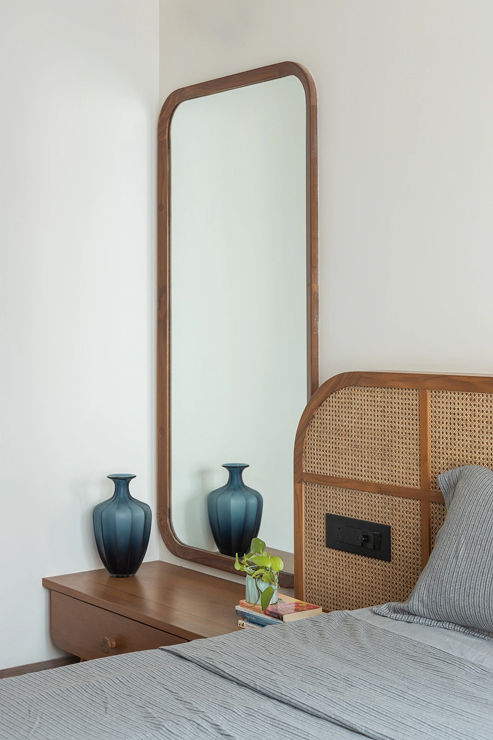
FACT FILE
Category
Interior
Year of Completion
2024
Typology
Residential
Location
Ahmedabad
Project Area (sqmt)
2,500
Lead Architect
andblack Team
A. Parekh Residence

A. Parekh Residence
residential | 2024
A. Parekh Residence
A. Parekh Residence
Parekh Residence explores continuity in living—where form, function, and detail are composed as fluid sequences rather than fixed parts.
Designed for two brothers living on separate floors of the same apartment building, the residence establishes a shared design language while allowing each home its own spatial identity. The entrance sequence sets the tone—a ripple-textured wooden door paired with its inverse in metal forms a layered threshold that is both functional and sculptural. This approach carries inward, where elements such as a curved console and a parametric screen shape the flow of space without enclosing it. Throughout the interiors, walls, partitions, and surfaces are designed not as boundaries, but as transitions.
This is a residence shaped by movement—where every edge, joinery, and gesture is designed to flow, soften, and hold space without interruption.
Each room builds on the idea of connection—between programs, between materials, and between built-in elements. A sliding wave-formed partition mediates the living and kitchen zones, allowing openness or separation as needed. Service areas are folded into grooved wood and blue panels, visually continuous with the surfaces around them. In the bedrooms, storage and display are embedded into architecture: shelves emerge from voids, beds link to cabinetry, and corners are softened into curves. The children’s room introduces play through form—curved walls, suspended study desks, and integrated seating that can adapt over time. Every decision reinforces flow, not fragmentation.


Parekh Residence explores continuity in living—where form, function, and detail are composed as fluid sequences rather than fixed parts.
Designed for two brothers living on separate floors of the same apartment building, the residence establishes a shared design language while allowing each home its own spatial identity. The entrance sequence sets the tone—a ripple-textured wooden door paired with its inverse in metal forms a layered threshold that is both functional and sculptural. This approach carries inward, where elements such as a curved console and a parametric screen shape the flow of space without enclosing it. Throughout the interiors, walls, partitions, and surfaces are designed not as boundaries, but as transitions.
This is a residence shaped by movement—where every edge, joinery, and gesture is designed to flow, soften, and hold space without interruption.
Each room builds on the idea of connection—between programs, between materials, and between built-in elements. A sliding wave-formed partition mediates the living and kitchen zones, allowing openness or separation as needed. Service areas are folded into grooved wood and blue panels, visually continuous with the surfaces around them. In the bedrooms, storage and display are embedded into architecture: shelves emerge from voids, beds link to cabinetry, and corners are softened into curves. The children’s room introduces play through form—curved walls, suspended study desks, and integrated seating that can adapt over time. Every decision reinforces flow, not fragmentation.
Image Index


A. Parekh Residence
FACT FILE
location
Ahmedabad
year of completion
2024
category
Interior
typology
Residential
built area (in sq.ft)
2,500
photography credits
-
notes
-
Parekh Residence explores continuity in living—where form, function, and detail are composed as fluid sequences rather than fixed parts.

Designed for two brothers living on separate floors of the same apartment building, the residence establishes a shared design language while allowing each home its own spatial identity. The entrance sequence sets the tone—a ripple-textured wooden door paired with its inverse in metal forms a layered threshold that is both functional and sculptural. This approach carries inward, where elements such as a curved console and a parametric screen shape the flow of space without enclosing it. Throughout the interiors, walls, partitions, and surfaces are designed not as boundaries, but as transitions.

This is a residence shaped by movement—where every edge, joinery, and gesture is designed to flow, soften, and hold space without interruption.
Each room builds on the idea of connection—between programs, between materials, and between built-in elements. A sliding wave-formed partition mediates the living and kitchen zones, allowing openness or separation as needed. Service areas are folded into grooved wood and blue panels, visually continuous with the surfaces around them. In the bedrooms, storage and display are embedded into architecture: shelves emerge from voids, beds link to cabinetry, and corners are softened into curves. The children’s room introduces play through form—curved walls, suspended study desks, and integrated seating that can adapt over time. Every decision reinforces flow, not fragmentation.
media gallery


A. Parekh Residence
FACT FILE
Category
Interior
Year of Completion
2024
Typology
Residential
Location
Ahmedabad
Area (sq.ft)
2,500
Lead Architect
Photography Credits
-
Parekh Residence explores continuity in living—where form, function, and detail are composed as fluid sequences rather than fixed parts.

Designed for two brothers living on separate floors of the same apartment building, the residence establishes a shared design language while allowing each home its own spatial identity. The entrance sequence sets the tone—a ripple-textured wooden door paired with its inverse in metal forms a layered threshold that is both functional and sculptural. This approach carries inward, where elements such as a curved console and a parametric screen shape the flow of space without enclosing it. Throughout the interiors, walls, partitions, and surfaces are designed not as boundaries, but as transitions.
Each room builds on the idea of connection—between programs, between materials, and between built-in elements. A sliding wave-formed partition mediates the living and kitchen zones, allowing openness or separation as needed. Service areas are folded into grooved wood and blue panels, visually continuous with the surfaces around them. In the bedrooms, storage and display are embedded into architecture: shelves emerge from voids, beds link to cabinetry, and corners are softened into curves. The children’s room introduces play through form—curved walls, suspended study desks, and integrated seating that can adapt over time. Every decision reinforces flow, not fragmentation.
This is a residence shaped by movement—where every edge, joinery, and gesture is designed to flow, soften, and hold space without interruption.








































































































